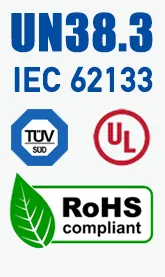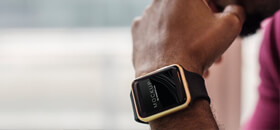
Hot news
Why does the mobile phone need a non-removable lithium-ion battery to replace the removable battery?
Does that mean that mobile phones with replaceable lithium-ion batteries will become the mainstream design in the future? Let's first take a look at the disadvantages of the removable battery. First, mobile phones are unlikely to be designed as thin and light as they are today. In today's mobile phones with non-removable batteries, the outer skin of the lithium-ion battery inside is made of aluminum-plastic film. You can think of it as the lithium-ion battery's outer shell, but it is skinny, with a thickness of only 0.1mm, which is not a shell. Learn more...
Flexible Lithium Battery Technology
More and more products have become flexible, and as an essential accessory, the lithium battery also needs to be flexible. We never stop improving the technology and production process on our flexible lithium battery from design to mass production. Learn more...
Mobile Phone Battery & Car Battery
Current lithium Ion battery is used for two fields. One is electric car, the other one is 3C products. 3C products are kinds of household appliances. The most extensive needs of the lithium ion battery are mobile phone which is a massive demand for people. Learn more...
What's graphene battery?
Graphene plays a role in enhancing the heat dissipation in the lithium cell, rather than adding graphene to the positive and negative electrodes of the lithium cell, so the graphene in this battery does not increase the charge and discharge rate, nor can it increase the energy density, nor enhance the conductivity. It is a lithium battery. For example, Huawei has produced a heat dissipation improved lithium battery. The graphene layer achieves the heat dissipation. Learn more...
Wireless Headphone Market Analytics
The wireless headphone market is overgrowing when Apple company publish the new wireless headphone - AirPods. Tim Cook also said, AirPods is the best seller, and it's subverted the market. More and more IT companies such as HUAWEI, MI, Microsoft, Amazon, OPPO, Vivo are planning to publish new products in 2019. In 2018, the sales quantity of all world was 46M, and the amount will be 129M in 2020. Learn more...
Smaller medical devices will have a subversive impact on health management practices.
Medical devices are ubiquitous in our lives, but as a sub-area of the pharmaceutical industry, its market is still relatively small, and it is not as important as drugs. It has neither a comprehensive technological breakthrough nor even a unified technology. The direction, every progress is only the doctor will pay attention. But all the growth is put together, but it will have a subversive impact on the health industry, that is, each of us manages our health. Learn more...
Lithium Ion Polymer Battery for Marketable Wearable Products
Big brands still have a relatively large dominance in the world, especially the earliest launcher of the bracelet, Fitbit, and Jawbone is also a great brand in the field of bracelets. (Curved lithium ion polymer batteries are fully utilized in the bracelet market). The function of the bracelet is relatively monotonous, the entry threshold is not high, the market competition is fierce, and the user demand is not so strong. Lear more...
Why are toys so favorite?
People have a higher tolerance for toys, while other Artificial Intelligence (AI) does not. For example, the Autopilot system can't be controlled in some cases. Google Translate can not become a good writer. The diagnostic efficiency of artificial intelligence is far lower than in hospitals. Smart toys are precisely an excellent opportunity for artificial intelligence to gain early market recognition. There is no competition between smart toys and high technology. Learn more...
Power Batteries for Electric Cars
The lithium-ion battery is the leader in power batteries for electric cars. The critical difference is the cathode materials which is the most crucial part of the lithium-ion battery. The cathode materials hold more than half of the battery, and the cost is also higher than 40%. The price of the battery is up to the cathode materials. There are lots of different cathode materials for power batteries. LiCoO is used for most lithium-ion batteries, but it's going down because of the higher cost and safe question. Learn more...
Apple's new MacBook gets the highest capacity with lipo batteries
To meet a hole woking time, Apple use every millimeter of space of new mabcook..They make a new battery technology. Some terraced lipo battery cells in a pack to fit the customs case. There is additonal 35% of capacity than general pack. All available space in the new 12'' MacBook is used. The new lipo batteries can up to 9 hours web browsing & 10 hours video playing. Learn more...
Apple company improve lithium polymer battery pack to increase battery life
It shows that apple will redesign lipo batteries for iPad, iPhone and MacBook to improve battery life. The new lipo battery pack will have some different size of lipo cells.
Apple Company is finding to extend the new concept battery pack and apply for patents to TRADEMARK LAW OF THE UNITED STATES OF AMERICA. The target is to improve the performance of lithium polymer battery packs in more and more electronic products, such as iPhone, iPad and MacBook. Some batteries are in in parallel to be a battery pack.
The cells in a pack are not different length and thickness. So that it will be up to the hilt to use the limited space. Now the capacity of lipo battery pack is higher a lithium ion battery, and also meet a higher voltage.
The custom lithium polymer battery pack can be designed for any size to fit most of products. For example, it can be assembled back to scream to increase capacity. In the same way, make more different length or thickness lipo battery packs but unsymmetrical in phones to fit for other parts, such as CPU, PCB, memory and so on.
Apple company is interest in improving battery life. In the early, they want to make a high density lithium polymer battery. Apple also would like to make external power supply, so that you can charge apple products when can’t find power supply.
Lithium polymer battery is competitive industry
Lithium polymer battery is used for many products, such as tablet PCs, laptops and other ultrathin electronics. The demand of market is growing. Ultrathin designed laptops will be reach 40% at the end of 2012. But apple company had taken over 40% of good suppliers for lithium polymer battery. The other companies DELL, Acer or Asus are searching new lithium polymer battery suppliers now.
For lack of supply, the price of lithium polymer battery is higher 20% than the second quarter of this year. But it can’t stop the more and more demand. Right now manufacturers in China, Korea and Japan are expanding their current capacity. In Korea 2011, lithium polymer battery is hold more than 20%-30% in the three battery manufacturers.
The great flexibility of lithium polymer battery lead to laptops be more thiner, To fit the customers requestment, HP, Dell, Asus, LG and Acer will design and produce unltrothin PCs to get larger market in future. Apple company is the biggest brand in PC market and most of apple products were build in lithium polymer battery. But to consider the higher cost and lower output, the other brands would like lithium ion battery 18650 replace lithium polymer battery.
The unltrathin PCs will be meet 40% of consumer PCs market at the end of next year. On the other side intel publish a new CPU “Sandy Bridge” for untrthin PCs.
The earthquake in Japan push lithium polymer battery manufacturing remove to China
Japan is the front ranks of the world in lithium polymer battery industry and they own more than 50% of material for lithium polymer battery. Japan has a complete industry chain from upstream of the material to downstream of the material, such as battery pack and circuit design.
The earthquake touches lithium polymer battery supply for global consumer electronics. Sony and Hitachi’s companies in Fukushima declare some battery manufacturers to stop working. They influence the current battery industry chain. Someone forecast that there will be a big gap of lithium polymer battery this year. But China and Korea have a enough capacity, they will be replace Japan to earn more market.
Japan economics news report that Panasonic will move more lithium polymer battery production from Japan to China for reducing the labor cost, so that they can keep the max quotient. Panasonic will invest more than USD 300,000,000 for set up a new and large manufacturer and update machines. On schedule, Panasonic wish to reduce cost more than 30% in 2015, and take over 50% of lithium polymer battery output. Right now 80%-90% of lithium polymer batteries made in Japan and the others are made in China.
China battery manufacturers have a big opportunity after Japan earthquake
After Japan earthquake, the material of lithium polymer battery, global aluminum foil has a big gap. The largest of aluminum foil manufacturer in Japan will cooperate with Dongyang company in China and set up joint venture company to provide more materials for lithium polymer batteries which used for cars. It show that the main battery output will remove from Japan to China.
The more and more companies from Taiwan pay more attention to China mainland market and join in exhibition together and show determination to take over the China market. Fierce competition will be happened soon. It’s reported, China (Shanghai) International battery and technology exhibition will be hold in Shanghai Guangda exhibition center on September 19th.
The replacement of Lithium polymer battery industrial is growing quickly
To consider our world, the more and more lead-acid batteries will be replaced by lithium polymer batteries. According to the preliminary statistics, two-thirds of lead-acid batteries will be reduced. In China government will produce all new energy resources cars for a new industrial. Lithium polymer batteries represent of the heart of new energy resources cars, battery manufacturer will have a great market and opportunity.
More and more battery companies come into the market, 36 lithium polymer battery companies take over 72% of all battery companies. Since 2010, 11 new company’s main product is lithium polymer battery, and 8 new company’s product is lead-acid battery. At the same time, lithium polymer battery industrial chain of company’s stocks growing well, such as BYD company with RMB18.0. The other lithium polymer battery company’s stock is following up.
China government publishes a new paper about <Save and New Energy Resources Car Industrial Plan> and reduce & avoid the tax of car to extend new resources car to the market. Lots of investment companies all over the world will pay more attention on battery exhibition in Shanghai on Sep. 2011 and will analyze and invest lithium polymer battery industrial.
NASA’s Glenn Research Center Partners with Fuentek to License Technology to Enhance Lithium polymer Battery
To enhances the performance and safety of lithium polymer battery, NASA’s Glenn Research Center has asked Fuentek to seek companies to license an advanced copolymer gel electrolyte. This electrolyte technology would enhance the performance of rechargeable lithium polymer battery and would be safer than existing batteries because there are no volatile or flammable components.
The new technology could be used in: wafer-thin geometries such as smart cards, cell phones, personal digital assistants (PDAs), laptops, digital music devices, wireless controllers, battery-powered robots, lightweight radio-controlled cars and aircraft, grid power storage and electric vehicles.
The technology enables a safer, highly flexible, and environmentally friendly fabrication method for producing lithium polymer battery with high ionic conductivity, high cycling stability, mechanical strength and potentially increased battery cycle life.
Advancements in technology, like NASA’s gel electrolyte, are imperative to advancing the search for effective alternative energy sources, senior technology transfer consultant at Fuentek, LLC. This electrolyte technology will allow companies to produce safer, more powerful lithium polymer battery for just about everything, from remote controlled cars to extending the capabilities of solar power through grid power storage.
Innovations like this one have the potential to boost economic development and create jobs. We’re working to make that happen.
(Source: http://www.fuentek.com/ )
Sanyo eyes tenfold increase in lithium ion battery capacity
KASAI Japan & Sanyo Electric, which make hybrid vehicle lithium ion battery for Ford and Honda, targets a tenfold increase in lithium ion battery production capacity in five years.They also aim to slash manufacturing costs by half in that time in its bid to become a leader in next-generation power packs for green cars.
Speaking last week at the opening of Sanyo's lithium ion battery factory in this western Japanese city, Sano predicted hybrid and electric vehicles will account for 10 to 15 percent of all new-car sales in 2020. Sanyo wants at least 30 percent of that global market, he said.Limited lithium ion battery production began at Kasai in July, with initial capacity of 1 million cells a month. Sanyo aims to raise that capacity to 10 million cells by 2015.
Sanyo did not say how many vehicles 10 million lithium ion cells could supply. But it could be enough for 125,000 hybrid vehicles a month, judging by the output of its Tokushima factory.The Tokushima plant, which opened last year for trial production, was Sanyo's first facility making lithium ion battery for cars. It has enough capacity for 100,000 cells a month, or enough for 15,000 hybrid vehicles a year. There are roughly 80 cells per battery pack.
(Source: http://www.autonews.com/)
Anode tech may lead to 30% higher capacity lith-ion battery
A research team at Japan's Advanced Industrial Science and Technology has developed a new anode technology that could boost the lifespan of a lithium-ion batteries charge by as much as 30 percent. The synthesis method, known as "soft chemistry," creates a titanium oxide that is significantly more efficient than the lithium titanate it would replace. Batteries could generate about 225mAh of power for each gram versus 175mAh today.
The technique can run at a relatively low temperature, making it easier to implement, and could also reduce the cost of the batteries themselves. Titanium oxide doesn't require relatively costly lithium to make, AIST said. Switching also doesn't affect the ability to maintain capacity over repeated charges. Researchers didn't say how soon they expected the new developments to find their ways into shipping products, though the development is relatively conventional and might become practical sooner than usual for battery research.
Research and Markets: Report Estimates the Lithium-Ion Polymer Battery Volume for Hybrid and EVs inside South Korea to Increase from Approximately 6,200 In 2009 To 201,500 In 2016
This research service includes analysis of lithium polymer battery technologies for electric and hybrid vehicles in South Korea. It includes market overview of definitions of hybrids and electric vehicles, schematic representation of mild hybrids, full hybrids and electric vehicles, hybrid and electric vehicle strategies of OEMs in South Korea, introduction of hybrids and electric vehicle models, industry challenges, market drivers and restraints, product and technology roadmaps. It also includes battery market that includes market life cycle analysis, market size and forecasts for hybrids and electric vehicles, market breakdown by type of alternative powertrain and type of batteries.
Research Overview This Frost & Sullivan research service titled Strategic Analysis of Battery Technologies for Electric and Hybrid Vehicles in South Korea provides an overview of the hybrid and electric vehicle (EV) market and type of battery technologies adopted in South Korea. It also includes market forecasts by type of motor, hybrid type, EV type, market drivers and restraints, partnership and distribution network and supplier profiles. In this research, Frost & Sullivan's expert analysts thoroughly examine the following markets: basic (A), sub-compact (B), compact (C), mid-size (D), large (E), large plus (F), multi-purpose vehicle (MPV), pick-up (PUP) and sport utility vehicle (SUV).
Lithium Polymer Batteries to Dominate the Battery Market for Hybrid and Electric Vehicles in South Korea
Hybrid and EVs are riding a wave of popularity, as increasing social responsibility and environment consciousness are driving consumers to invest in fuel-efficient and low-emission vehicles. Original equipment manufacturers (OEMs) and suppliers will be keen to make the most of this trend and showcase their Green image by promoting zero-emission vehicles. Their endeavours are expected to expand the market size of hybrids from approximately 13,100 in 2010 to 131,500 in 2016 and EVs from 150 in 2010 to nearly 74,000 in 2016. Consequently, Frost & Sullivan estimates the lithium-ion polymer battery volume for hybrid and EVs to increase from approximately 6,200 in 2009 to 201,500 in 2016 at a compound annual growth rate (CAGR) of 65 per cent. The volume of lead-acid batteries is likely to increase from 13,780 in 2009 to 368,800 in 2016 at a CAGR of 55 per cent.
To tap the hybrid and EV market optimally, battery manufacturers have to tweak their technology. As hybrid and EV manufacturers are not completely satisfied with the current batteries, market participants will be compelled to develop advanced battery technologies such as Zinc Air batteries that help increase range and top speed, especially in EVs. Presently, lithium ion battery is still at research and development stages and the technology has not been proven yet, says the analyst of this research. OEMs need to develop a variety of hybrid and EV models to compete with conventional vehicles. New technologies and rapid improvements in hybrid powertrains, resulting in greater fuel efficiency, reliability, lifespan and improved performance, is a step in that direction.
Power electronics suppliers have a wide range of opportunities for the integration of battery monitoring units for battery application in hybrid and EVs. The battery control unit is integrated along with the battery and will be controlled by a centralised hybrid or EV controller. Batteries are likely to be the main storage units and will influence the future design and testing of vehicles for OEMs, notes the analyst. OEMs and suppliers have to collaborate closely to develop batteries to catalyse the commercialization of alternative powertrain vehicles.
(Source: http://www.businesswire.com)



